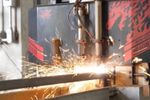Metal ducts at industrial facilities come in all shapes and sizes but they can be divided into two main types.
On the one hand, there are the massive ducts that complement processing equipment. These ducts work to provide boilers with air so they can fire and also remove gases and particulates from boilers and process systems.
On a smaller scale, ducts form an integral part of any plant’s HVAC system, introducing fresh air into the workspace and removing contaminants. Although HVAC ducts are generally smaller than process ducts, they can still fall in the category of “heavy ductwork fabrication” as is the case in the mining and power industries, for example.
Process Ductwork
Process ductwork for heavy industrial applications, such as at cement and power plants, needs to be built to take abuse. It has to be thick and durable so that it can put up with the hot, abrasive, and corrosive materials it will come into contact with. Sections of process ductwork are typically made out of 1/4” or 5/16” carbon steel plate and can be up to 360” long.
 Round and rectangular ductwork in progress on the shop floor at Southern Metal Fabricators.
Round and rectangular ductwork in progress on the shop floor at Southern Metal Fabricators.
Most process ductwork gets coated with a thick shellac or specialty coating so that it can endure in its harsh work environment. It’s also often lined with ceramic to enhance its heat and abrasion resistance, which comes in handy in a foundry or a sand plant, for example. In cases where special tiles are applied to duct interiors, the metal sections of ductwork are first manufactured by custom metal fabricators and then shipped to OEMs that then apply the linings.
While process ductwork needs to be robust, it also needs to be very precise. Process ductwork is highly engineered to specific sizes and has to abide by very strict tolerances so that it can maintain system pressure, which directly affects a process system’s efficiency and performance.
Depending on its application, process ductwork can be either rectangular or round. Most cement plant ductwork, for example, is round because it requires fewer stiffeners. Power plant ductwork, on the other hand, is usually rectangular and incorporates heavy stiffeners every 2” to 6” to minimize vibrations.
HVAC Ductwork
HVAC ductwork is used in all plants for heating, ventilation, and air conditioning (HVAC). It is a primary component in the environmental systems that ensure indoor air quality and regulate indoor air temperature by supplying air to a facility and, in turn, removing air from it.
HVAC ducts are generally made out of galvanized steel or aluminum. Ducts can be lined with polyurethane or fiberglass for insulation, although simply wrapping HVAC ductwork in fiberglass blanket insulation is the most common for of insulation.
Because HVAC ductwork is made from rust-resistant metals (galvanized steel or aluminum), it often remains uncoated. External ductwork that is exposed to weather can be coated with laminates, polymers, or other waterproof coatings for additional protection from the elements.
Like process ductwork, HVAC ductwork comes in rectangular and round varieties. Rectangular HVAC ducts range anywhere from 3” to 40” on a side while round ducts can be anywhere between 6” and 42” in diameter.
Custom Ducts
 Not the biggest duct we’ve ever built, but still pretty darn large.
Not the biggest duct we’ve ever built, but still pretty darn large.
Here are Southern Metal Fabricators, we’re equal opportunity duct makers. The way we figure it, ducts for industrial applications, whether process ducts or HVAC ducts, are always going to be custom jobs. And custom is what we specialize in.
Whether you’re looking for heavy-duty process ductwork with lots of stiffeners or lightweight interior aluminum HVAC ductwork that’s easy to assemble, we manufacture all shapes and sizes. Ducts we fabricate typically range from 6” exhaust ducts that pull heat off of equipment to 144”-diameter process ductwork, including branches, elbows, offsets, and transitions. We even do dampers and expansion joints.
If you’ve got a job you think we can handle, be sure to call us at 1.888.421.9661 and give us a chance to say, “Yes, we can do that!”





